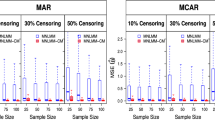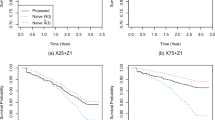Abstract
We consider longitudinal clinical data for HIV patients undergoing treatment interruptions. We use a nonlinear dynamical mathematical model in attempts to fit individual patient data. A statistically-based censored data method is combined with inverse problem techniques to estimate dynamic parameters. The predictive capabilities of this approach are demonstrated by comparing simulations based on estimation of parameters using only half of the longitudinal observations to the full longitudinal data sets.
Similar content being viewed by others
References
Adams, B.M., 2005. Non-parametric parameter estimation and clinical data fitting with a model of HIV Infection. PhD Thesis, NC State University, Raleigh.
Adams, B.M., Banks, H.T., Davidian, M., Kwon, H.D., Tran, H.T., Wynne, S.N., Rosenberg, E.S., 2005. HIV dynamics: Modeling, data analysis, and optimal treatment protocols. J. Comput. Appl. Math. 184(1), 10–49.
Adams, B.M., Banks, H.T., Davidian, M., Rosenberg, E.S., 2005. Model fitting and prediction with HIV treatment interruption data, Center for Research in Scientific Computation Technical Report CRSC-TR05-40, NC State University, Raleigh, October. Online:http://www.ncsu.edu/crsc/reports.
Adams, B.M., Banks, H.T., Tran, H.T., Kwon, H., 2004. Dynamic multidrug therapies for HIV: Optimal and STI control approaches. Math. Biosci. Eng. 1(2), 223–241.
Aitkin, M., 1981. A note on the regression analysis of censored data. Technometrics 23, 161–163.
Armstrong, S., Fontaine, C., Wilson, A., 2004. 2004 Report on the Global AIDS Epidemic. UNAIDS/Joint United Nations Programme on HIV/AIDS, Geneva, Switzerland. Online:http://www.unaids.org.
Banks, H.T., Kunisch, K., 1989. Estimation Techniques for Distributed Parameter Systems. Birkhauser, Boston.
Banks, H.T., Kwon, H., Toivanen, J.A., Tran, H.T., 2006. An SDRE-based estimator approach for HIV feedback control [Technical Report CRSC-TR05-20, NC State University, Raleigh, April]. Optim. Control Appl. Methods 27, 93–121.
Bonhoeffer, S., Rembiszewski, M., Ortiz, G.M., Nixon, D.F., 2000. Risks and benefits of structured antiretroviral drug therapy interruptions in HIV-1 infection. AIDS 14, 2313–2322.
Callaway, D.S., Perelson, A.S., 2002. HIV-1 infection and low steady state viral loads. Bull. Math. Biol. 64(1), 29–64.
Dempster, A.P., Laird, N.M., Rubin, D.B., 1977. Maximum likelihood from incomplete data via the EM algorithm. J. R. Stat. Soc., Ser. B 39(1), 1–38.
Finkel, D.E., 2005. Global optimization with the DIRECT algorithm. PhD Thesis, NC State University, Raleigh. Online:http://www4.ncsu.edu/definkel/research/Direct.m.
Hindmarsh, A.C., 1983. Scientific Computing. Chapter ODEPACK, A Systematized Collection of ODE Solvers, North-Holland, Amsterdam, pp. 55–64. Online:http://www.llnl.gov/CASC/odepack/.
Kalbfleisch, J.P., Prentice, R.L., 2002. The Statistical Analysis of Failure Time Data. Wiley, New York.
Kassutto, S., Maghsoudi, K., Johnston, M.N., Robbins, G.K., Burgett, N.C., Sax, P.E., Cohen, D., Pae, E., Davis, B., Zachary, K., Basgoz, N., D'agata, E.M.C., DeGruttola, V., Walker, B.D., Rosenberg, E.S., 2006. Longitudinal analysis of clinical markers following antiretroviral therapy initiated during acute or early HIV-1 infection. Clin. Infect. Dis. 42, 1024–1031.
Kelley, C.T., 1999. Iterative methods for optimization. In: Frontiers in Applied Mathematics FR18. SIAM, Philadelphia.
Klein, J.P., Moeschberger, M.L., 2003. Survival Analysis: Techniques for Censored and Truncated Data. Springer, New York.
Lichterfeld, M., Kaufman, D.E., Yu, G., Mui, S.K., Addo, M.M., Johnston, M.N., Cohen, D., Robbins, G.K., Pae, E., Alter, G., Wurcel, A., Stone, D., Rosenberg, E.S., Walker, B.D., Altfield, M., 2004. Loss of HIV-1-specific CD8+ T-cell proliferation after acute HIV-1 infection and restoration by vaccine-induced HIV-1-specific CD4+ T-cells. J. Exp. Med. 200(6), 701–712.
Lori, F., Lisziewicz, J., 2001. Structured treatment interruptions for the management of HIV infection. J. Am. Med. Assoc. 4286(23), 2981–2987.
McLachlan, G.J., Krishnan, T., 1997. The EM Algorithm and Extensions. Wiley, New York.
Norris, P.J., Rosenberg, E.S., 2002. CD4+ T-helper cells and the role they play in viral control. J. Mol. Med. 80, 397–405.
Nowak, M.A., Bangham, C.R.M., 1996. Population dynamics of immune responses to persistent viruses. Science 272, 74–79.
Perelson, A.S., Nelson, P.W., 1999. Mathematical analysis of HIV-1 dynamics in vivo. SIAM Rev. 41(1), 3–44.
Rosenberg, E.S., Altfield, M., Poon, S.H., Phillips, M.N., Wilkes, B., Eldridge, R.L., Robbins, G.K., D'Aquila, R.D., Goulder, P.J.R., Walker, B.D., 2000. Immune control of HIV-1 after early treatment of acute infection. Nature 407, 523–526.
Schneider, H., 1986. Truncated and Censored Samples from Normal Populations. Marcel Dekker, New York.
Wodarz, D., Nowak, M.A., 1999. Specific therapy regimes could lead to long-term immunological control of HIV. Proc. Natl. Acad. Sci. 96(25), 14464–14469.
Author information
Authors and Affiliations
Corresponding author
Rights and permissions
About this article
Cite this article
Adams, B.M., Banks, H.T., Davidian, M. et al. Estimation and Prediction With HIV-Treatment Interruption Data. Bull. Math. Biol. 69, 563–584 (2007). https://doi.org/10.1007/s11538-006-9140-6
Received:
Accepted:
Published:
Issue Date:
DOI: https://doi.org/10.1007/s11538-006-9140-6





